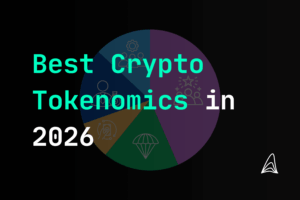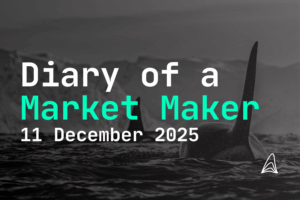
Liquidity Mining vs Staking vs Yield Farming - Comparison
Table of Contents

Jakob Brezigar
Jakob, an experienced specialist in the field of cryptocurrency market making, boasts an extensive international presence. With Orcabay, he has skillfully managed major operations and deals for a wide array of global stakeholders.
What is liquidity mining?
Liquidity mining is a process where users provide liquidity to a platform, usually by depositing assets into a pool, and in return, they earn rewards. These rewards are typically in the form of tokens.
How does liquidity mining differ from staking?
While both provide rewards, staking involves locking up a cryptocurrency to support network operations like block validation. Liquidity mining focuses on supplying assets to liquidity pools for trading purposes.
What are the risks of liquidity mining?
Risks include impermanent loss, where the value of deposited assets can decrease compared to holding them, smart contract vulnerabilities, and market volatility affecting reward value.
In the intricate realm of cryptocurrencies, the introduction of Decentralized Finance (DeFi) – commonly referred to as the revolutionary step in the financial domain – has offered multifaceted ways for users to optimize and grow their cryptocurrency holdings. Primarily, staking, yield farming, and liquidity mining emerge as the dominant techniques within this space. Each has its intricacies and applications, making them distinctly crucial in the DeFi space.
Greater Liquidity
In the decentralized world, liquidity remains a pivotal aspect. Liquidity, in essence, signifies the ease with which digital assets can be converted to cash or equivalent without affecting the asset’s price. High liquidity in a decentralized exchange (DEX) ensures smoother trading experiences and prevents market volatility.
This pressing need for greater liquidity gave rise to liquidity providers. They supply their cryptocurrency assets to liquidity pools on decentralized exchanges, ensuring a smoother flow of trading and an elevated trading volume.
What is DeFi liquidity mining?
Liquidity mining, often associated with liquidity providers, is a cutting-edge method in the decentralized finance market. It involves users providing liquidity to a liquidity pool in a decentralized exchange, and in return, they earn rewards, typically in the form of additional tokens.
The act of providing liquidity boosts the decentralized finance platform, enabling DEXs to facilitate trades instantly without causing significant price impacts. It’s a form of crypto liquidity mining that has gained immense popularity in recent times, proving to be a cornerstone in the this realm.

Liquidity Mining Benefits the DeFi Market
When you delve deep into the benefits of liquidity mining, the decentralized finance market stands as a prime beneficiary. As more and more users engage in liquidity mining, liquidity pools witness a surge in crypto assets. With an abundance of assets in the liquidity pools, defi exchange can handle significantly larger trade volumes.
This not only ensures an increased liquidity but also makes such exchanges a formidable competitor against traditional centralized exchanges. The broadening of liquidity fosters a conducive environment for market participants, making trading more seamless and less prone to slippages.
Increased Network Security
Diversification is the key. With a surge in the number of participants and a vast influx of liquidity, the overall security of the blockchain network is fortified. A well-distributed pool of liquidity providers diminishes the chances of market manipulations.
By spreading assets across various liquidity pools, it becomes daunting for adversaries to launch attacks on a particular network, ensuring that the blockchain network remains secure. Further, as more participants engage by adding their crypto assets to different liquidity pools, it enhances the robustness of the underlying system.
This wide distribution ensures that a single entity doesn’t gain undue influence or control, mitigating the risks of potential monopolistic behaviors or fraudulent activities. Validating transactions becomes smoother with increased participants, reinforcing the overall integrity of the system.
Additionally, as DeFi protocols incorporate various financial mechanisms, including derivatives contracts, the stability brought about by diversified assets becomes even more critical. This multifaceted approach ensures a more resilient and secure ecosystem for all users involved.
Liquidity mining, in its essence, involves users depositing or “locking-up” their cryptocurrency assets in a liquidity pool within a DeFi exchange. In return for their service, they earn rewards, often provided in the platform’s native governance tokens or a fraction of transaction fees. This rewarding system not only ensures a constant influx of liquidity but also promotes the distribution of these tokens to users, thereby democratizing the decision-making process in the DeFi protocol.
DeFi offers myriad avenues for earning. From staking cryptocurrency assets to reap staking rewards, to delving into the intricacies of yield farming or by becoming a liquidity provider in liquidity pools – there’s no dearth of opportunities. Yield farming, in particular, remains a dominant strategy. Yield farmers utilize their crypto holdings to earn the highest possible annual percentage yield (APY). However, while the promise of earn passive income is enticing, it’s paramount to understand the risks involved, particularly when engaging with newer DeFi protocols.

A significant advantage of liquidity mining over traditional cryptocurrency mining is its negligible energy footprint. Traditional mining demands high computational power, translating to elevated electricity consumption. In contrast, liquidity mining bypasses this by focusing on providing liquidity, making it a more environmentally conscious choice, and a sustainable approach in the digital assets domain.
Liquidity mining isn’t just about earning passive income. By participating, users often acquire governance tokens. These tokens are pivotal in decentralized protocols, allowing users to have a voice in the future trajectory of the DeFi protocol. It propagates a more decentralized ecosystem, enabling every provider of liquidity to contribute to the project’s roadmap and decisions.
Several DeFi platforms, from nascent projects to established entities, are now endorsing liquidity mining. Leading decentralized exchanges like Uniswap, Balancer, and SushiSwap have been at the forefront. Each platform has its unique set of rewards, governance tokens, and terms, necessitating a comprehensive understanding before any engagement.
These platforms are actively attracting miners by offering them lucrative incentives for providing liquidity to their respective pools. The rise of DeFi liquidity mining is predominantly due to the enthusiasm of market participants who see potential in locking up their assets to support the ecosystem and, in return, earn rewards.
As the landscape of DeFi expands, so do the intricacies and strategies associated with different liquidity mining programs. Each of these platforms designs its liquidity mining program in a manner that best aligns with its operational objectives and the benefits it wants to offer its users.
This dynamic environment underscores the importance of thorough research and due diligence for liquidity miners before choosing a platform and diving into the deep end of liquidity mining.

Liquidity pools play a pivotal role in DeFi as they provide liquidity. These are essentially smart contracts that contain reserves of two tokens, ensuring that trading operations can be carried out promptly. As traders execute their trades, algorithms within the pools recalibrate prices to reflect the new token ratios, ensuring fluidity in every transaction.
Liquidity providers are the backbone of DeFi’s success. By committing their funds to these pools, they facilitate seamless trades, ensuring that users can swap tokens without substantial slippage. In return, these providers often reap rewards for their services, but it’s not without its share of risks. Balancing the potential returns with inherent risks is key for every provider.
Why would someone choose to provide liquidity? Beyond the allure of rewards and passive income, many providers believe in the decentralized ethos of DeFi platforms. They view their role not just as a means to profit but as a crucial contribution to the cryptocurrency ecosystem’s decentralization and resilience.
While liquidity pools can offer lucrative opportunities, they come with their set of challenges. On the positive side, they allow for decentralized exchanges to function seamlessly, offering rewards for those who provide liquidity. However, they can also expose providers to phenomena like impermanent loss, where the value of their staked assets could decrease compared to just holding them.
The burgeoning world of liquidity mining often flaunts the allure of substantial returns, sometimes dwarfing those of traditional financial instruments. The promise of high annual percentage yield (APY) and the acquisition of governance tokens make it an attractive investment strategy.
However, it’s vital to juxtapose the potential returns against the inherent risks, especially in a market known for its volatility. For many, the concept of earning passive income through liquidity mining has become synonymous with yield farming, where investors hop between various DeFi protocols to maximize their returns.
The use of automated market makers, platforms that facilitate decentralized asset trading without needing an order book, has further streamlined this process, opening up opportunities for even low capital investors. These platforms often provide better yields than conventional means. However, as with any investment strategy, it’s essential to be well-informed and not be swayed solely by the allure of high returns.
Diversification and understanding the nuances of each platform, like how automated market makers operate, can be instrumental in navigating this promising yet complex landscape.

Absolutely. As with all ventures in the cryptocurrency market, liquidity mining carries risks. The most pronounced is the risk of impermanent loss. This occurs when the value of deposited assets in a liquidity pool diminishes compared to if they were held outside. Additionally, factors like project risks, market fluctuations, and vulnerabilities can exacerbate losses.
Choosing to mine in pools with low liquidity can further escalate these risks. Pools with low liquidity often suffer from price slippages, which can negatively affect the returns for liquidity miners. Furthermore, project risk is not to be underestimated.
If the project associated with a particular liquidity pool fails or comes under scrutiny, those who chose to liquidity mine might see a drastic decline in their returns or even lose money. A thorough understanding of the specific dynamics and nuances associated with each liquidity pool is paramount.
It’s imperative for participants to conduct diligent research and possibly consult experts before deciding where and how to liquidity mine, to mitigate potential pitfalls and optimize gains.
The essence of liquidity mining lies in its reward system. By allocating your cryptocurrency assets to liquidity pools, you’re not just bolstering trading activity; you’re also positioning yourself to earn rewards. These rewards can be in the form of interest, additional tokens, or even a portion of the trading fees accrued by the DeFi exchange. This mechanism not only incentivizes liquidity providers but also ensures a steady inflow of funds into the liquidity pools.
The act of providing liquidity is a fundamental cog in the wheel of DeFi systems. Liquidity provision essentially means making assets available for trading or borrowing. When one chooses to supply liquidity, it involves committing assets to the pool so that market participants have adequate funds to borrow or trade.
Involving oneself in providing liquidity offers dual benefits – not only does it provide a chance to earn, but it also plays a pivotal role in keeping the decentralized ecosystem fluid and functional. It’s a dynamic interplay wherein supplying liquidity feeds into the larger architecture, ensuring seamless transactions and fostering a robust platform.
Every investment avenue, especially in the decentralized finance domain, carries risks. Beyond the volatility of the crypto assets themselves, one must consider risks like impermanent loss, potential flaws in the DeFi protocol’s smart contracts, and the threat of “rug pulls” where project developers might abscond with users’ funds. As the adage goes, “Never invest more than you can afford to lose,” and this holds especially true in the volatile world of DeFi.
Liquidity mining, for many, presents an alluring proposition. The potential to earn passive income, coupled with the chance to participate in the governance of a DeFi protocol, makes it compelling. However, determining if liquidity mining is worth the effort and potential risks requires a well-researched and informed approach. Given the prospective returns and the rapid evolution of the DeFi market, it’s undoubtedly a strategy that beckons attention.
At its core, liquidity mining involves providing liquidity to certain platforms, and in return, participants often receive liquidity pool tokens as a representation of their stake. These tokens not only grant them a share in the rewards but can also be used in some systems to validate transactions.
Many participants see it as an optimal way to put their idle crypto assets to work, especially when the traditional holding strategy might not be yielding desired outcomes. The process, essentially involving providing liquidity, can be seen as both a means to diversify one’s crypto portfolio and to engage more dynamically with the ever-growing world of decentralized platforms.

Breaking it down, liquidity mining requires users to deposit their digital assets into a liquidity pool on a decentralized exchange. As trades occur, these liquidity providers earn a fraction of the trading fees, and often, they receive additional rewards in the form of the platform’s governance tokens. This double-fold reward mechanism – earning from trading fees and acquiring tokens – distinguishes liquidity mining from other passive income streams.
A rug pull is a malicious maneuver within the crypto space where developers abandon a project and run off with users’ funds. Given the decentralized nature, the lack of a centralized entity to oversee activities means that individuals must exercise caution. Due diligence, thorough research, and staying updated with community sentiments are paramount to mitigate such risks.
The allure of DeFi lies significantly in its potential to earn passive income. Liquidity mining, staking, and yield farming are the primary avenues. By locking in crypto assets, users can reap returns in the form of rewards, interest payments, and even a fraction of transaction fees from trading activity on decentralized exchange.
No high reward comes without risks. From the vulnerability of smart contracts to market volatility and the potential for malicious actors in newer, less-vetted DeFi protocols, there’s a plethora of risks. Engaging with established platforms, understanding the underlying contracts, and diversifying holdings can offer a shield against potential pitfalls.
While both liquidity mining and staking allow users to earn rewards by participating in the decentralized ecosystem, their mechanics differ. Staking involves locking up tokens to validate transactions on the blockchain network, whereas liquidity mining entails providing assets to liquidity pools to facilitate trades and in return, claim governance tokens and a share of trading fees.
A unique facet of liquidity mining is its inherent community-building aspect. As participants earn governance tokens, they become stakeholders in the project’s future, fostering trust and loyalty. This symbiotic relationship ensures the longevity and vibrancy of the DeFi protocol, cultivating a thriving decentralized ecosystem.
Liquidity mining distinguishes itself with its dual reward system. Unlike other passive income streams where returns might be solely based on interest or staking rewards, liquidity mining offers a combination of trading fee earnings and governance token acquisitions. This makes liquidity mining a potentially more lucrative, albeit riskier, strategy compared to other passive investment strategies.
Staking allows users to earn rewards by helping to keep a blockchain network secure. Yield farming, a subset of liquidity mining, is more strategy-intensive, where users move assets across various liquidity pools in DeFi platforms to chase the highest returns. Liquidity mining, a broader term, focuses primarily on providing liquidity to decentralized exchanges and earning both from trading fees and token rewards.
The promise of higher returns, especially compared to traditional financial instruments, is one of the primary benefits of liquidity mining. While the exact returns are contingent on market dynamics, platform terms, and the assets involved, many liquidity providers have touted significant gains, making it an appealing venture.
The nascent nature of the DeFi space means it often operates in a regulatory gray area. Changing legislation can significantly impact the viability and profitability of liquidity mining, posing a substantial risk to liquidity providers. Keeping abreast of global regulatory sentiments becomes paramount for anyone looking to delve deep into this domain.

One of the key attractions of liquidity mining is the potential to acquire new tokens, especially governance tokens of emerging projects, before they become mainstream on centralized exchanges. This early-bird advantage can translate to substantial gains, especially if the project garners significant traction.
To entice users to provide liquidity, many DeFi projects adopt strategies like incentivizing liquidity providers with unique rewards. Often, these rewards come in the form of liquidity tokens, representing the user’s stake in the liquidity pool. As participants involve themselves in providing liquidity to these nascent projects, they receive LP tokens, which can be a blend of the original tokens they’ve staked and the project’s native tokens.
Over time, as the platform’s user base and utility grow, the value of these liquidity tokens may rise. It’s this unique blend of gaining early access and the chance to be a part of a project’s growth trajectory that makes liquidity mining an attractive proposition for many crypto enthusiasts.
Impermanent loss is an inherent risk of liquidity mining. It arises when the value of assets in a liquidity pool diverges unfavorably from holding the same assets outside the pool. The nuanced dynamics of DeFi exchange, paired with the ever-volatile cryptocurrency market, can exacerbate this phenomenon. Understanding its intricacies is vital before committing assets.
It’s crucial to note that impermanent loss isn’t limited to DeFi alone; similar principles can occur on centralized cryptocurrency exchanges as well. When market participants choose to provide liquidity, particularly in yield farming scenarios, they often pivot their investment strategy based on potential returns. While this strategy can lead to impressive gains, it is essential to recognize the underlying risks, especially when considering the impermanent loss.
Yield farming, despite its attractive returns, requires due diligence to avoid unforeseen losses and to harness its benefits wisely. Investors should always be informed and cautious about where they allocate their resources in the crypto space.
The backbone of any DeFi protocol is its smart contracts. However, not all DeFi platforms have foolproof smart contracts. Vulnerabilities can lead to substantial losses, making it crucial to engage with platforms that have undergone rigorous security audits.
The DeFi ecosystem is not just susceptible to internal vulnerabilities. External dynamics, such as regulatory shifts, market manipulations, and sophisticated flash loan attacks, can significantly impact the rewards and risks associated with liquidity mining.
Undoubtedly, liquidity mining is not a risk-free venture. The balance between potential returns and associated risks is fragile. From market fluctuations to vulnerabilities in smart contracts and regulatory uncertainties, the risk profile is multifaceted. Therefore, it is vital for potential liquidity providers to be well-informed and cautious.

As DeFi continues to evolve, the debate surrounding the worthiness of liquidity mining intensifies. The juxtaposition of potential high returns against the inherent risks makes it a contentious subject. While it’s undeniable that liquidity mining offers avenues to optimize cryptocurrency holdings, the underlying importance of research, community engagement, and risk mitigation can’t be emphasized enough.
In sum, liquidity mining, with its intricacies and potential rewards, has firmly positioned itself in the heart of the DeFi revolution. Like all investment avenues, it demands understanding, research, and caution. For those willing to navigate its complexities, liquidity mining can indeed be a rewarding journey.



